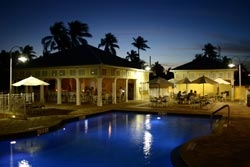 |
Magnum Inspections Inc. Serving South Florida Since 1994 Martin County: (772) 214-9929 Broward/Palm Beach Counties: (954) 340-6615 Email me at: ev@magnuminspections.com |
|
|
|
 |
Magnum Inspections Inc. Serving South Florida Since 1994 Martin County: (772) 214-9929 Broward/Palm Beach Counties: (954) 340-6615 Email me at: ev@magnuminspections.com |
|
|
|
|
|
This page will deal with different types of foundations. The foundation is the part of the structure that contacts the earth. It must be capable of holding the structure, and prevent excessive settlement. The house structure is attached to the foundation. Foundations today are generally made of concrete, or CMU (cement masonry units or cement blocks). Almost all foundations are reinforced with steel bar called rebar.
Foundation Construction Types
Slab-on-grade: Slab-on-grade foundations are a building engineering practice whereby the concrete slab that is to serve as the foundation for the structure is formed from a mold set into the ground. The concrete is then poured into the mold, leaving no space between the ground and the structure. This type of construction is most often seen in warmer climates, where ground freezing and thawing is less of a concern and where there is no need for heat ducting underneath the floor.
The advantages of the slab technique are that it is relatively cheap and sturdy, and is considered less vulnerable to termite infestation because there are no hollow spaces or wood channels leading from the ground to the structure (assuming wood siding, etc., is not carried all the way to the ground on the outer walls). The disadvantages are the lack of access from below for utility lines, a tendency to transmit cold upward in areas where ground temperatures fall significantly, and a very low grade elevation that may expose the building to flood damage in even moderate rains. Remodeling or extending such a structure may also be more difficult.
Over the long term, ground settling (or subsidence) may be a problem, as a slab foundation cannot be readily jacked up to compensate; proper soil compaction prior to pour can minimize this. The slab can be decoupled from ground temperatures by insulation, with the concrete poured directly over insulation (for example, Styrofoam panels), or heating provisions (such as hydronic heating) can be built into the slab (an expensive installation, with associated running expenses).
Care must be taken with the provision of services through the slab. Copper piping, commonly used to carry natural gas and water, reacts with concrete over a long period, slowly degrading until the pipe fails. Copper pipes must be lagged, run through a conduit, or plumbed into the building above the slab. Electrical conduits through the slab need to be water-tight, as they extend below ground level and can potentially expose the wiring to groundwater.
Monolithic:
Slabs are most common in warmer
areas such as Florida, Arizona, California and Texas. Since
there is often a shallow frost line, or no frost line at all
the footings and slab can be poured right on top of the
ground. The footings and slab can often be poured at the
same time. When the footings and slab are poured together it
is called a monolithic slab.
Supported: The supported slab is similar to a monolithic slab, with the exception that the slab it self is poured over two to three courses of concrete block which make up the footings. The block is laid first, then, the slab poured over the footings. This method was used in the sixties and seventies, but gave way to the easier and cheaper monolithic slabs.
Crawl spaces:
Crawlspace is more popular in
moderate climates such as the Pacific Northwest, the
mid-Atlantic coast. The footings are placed below the frost
line, and a stem wall is placed on top of the footing. The
sub-floor structure is placed on top of the foundation. The
typical critical path schedule for crawlspaces is:
Footings, foundation,
plumbing, backfill, framing and HVAC (note: subfloor
plumbing and HVAC can be done after floor framing if
necessary.) Basement: Basements are most often built in cold weather climates such as the Northeast, Midwest and Rocky Mountains. The footings in these colder climates need to be below the frost line which is fairly deep in these areas. Basements provide the cheapest square footage in most instances.
Martin County: (772) 214-9929 Broward/Palm Beach Counties: (954) 340-6615 Email me at: ev@magnuminspections.com |
|
||
|
Copyright Magnum Inspections Inc. 1994-2018--All Rights Reserved |